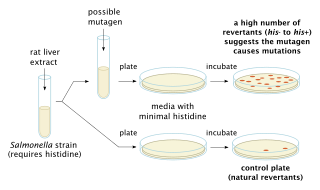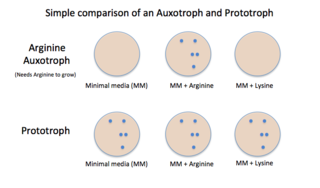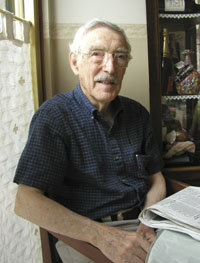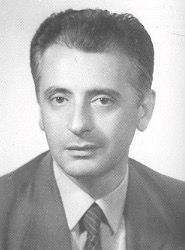Related Research Articles

The Ames test is a widely employed method that uses bacteria to test whether a given chemical can cause mutations in the DNA of the test organism. More formally, it is a biological assay to assess the mutagenic potential of chemical compounds. A positive test indicates that the chemical is mutagenic and therefore may act as a carcinogen, because cancer is often linked to mutation. The test serves as a quick and convenient assay to estimate the carcinogenic potential of a compound because standard carcinogen assays on mice and rats are time-consuming and expensive. However, false-positives and false-negatives are known.
Mutagenesis is a process by which the genetic information of an organism is changed by the production of a mutation. It may occur spontaneously in nature, or as a result of exposure to mutagens. It can also be achieved experimentally using laboratory procedures. A mutagen is a mutation-causing agent, be it chemical or physical, which results in an increased rate of mutations in an organism's genetic code. In nature mutagenesis can lead to cancer and various heritable diseases, and it is also a driving force of evolution. Mutagenesis as a science was developed based on work done by Hermann Muller, Charlotte Auerbach and J. M. Robson in the first half of the 20th century.

In genetics, a mutagen is a physical or chemical agent that permanently changes genetic material, usually DNA, in an organism and thus increases the frequency of mutations above the natural background level. As many mutations can cause cancer in animals, such mutagens can therefore be carcinogens, although not all necessarily are. All mutagens have characteristic mutational signatures with some chemicals becoming mutagenic through cellular processes.

ENU, also known as N-ethyl-N-nitrosourea (chemical formula C3H7N3O2), is a highly potent mutagen. For a given gene in mice, ENU can induce 1 new mutation in every 700 loci. It is also toxic at high doses.
Genotoxicity is the property of chemical agents that damage the genetic information within a cell causing mutations, which may lead to cancer. While genotoxicity is often confused with mutagenicity, all mutagens are genotoxic, but some genotoxic substances are not mutagenic. The alteration can have direct or indirect effects on the DNA: the induction of mutations, mistimed event activation, and direct DNA damage leading to mutations. The permanent, heritable changes can affect either somatic cells of the organism or germ cells to be passed on to future generations. Cells prevent expression of the genotoxic mutation by either DNA repair or apoptosis; however, the damage may not always be fixed leading to mutagenesis.

Auxotrophy is the inability of an organism to synthesize a particular organic compound required for its growth. An auxotroph is an organism that displays this characteristic; auxotrophic is the corresponding adjective. Auxotrophy is the opposite of prototrophy, which is characterized by the ability to synthesize all the compounds needed for growth.

Bruce Nathan Ames is an American biochemist. He is a professor of Biochemistry and Molecular Biology Emeritus at the University of California, Berkeley, and was a senior scientist at Children's Hospital Oakland Research Institute (CHORI). He is the inventor of the Ames test, a system for easily and cheaply testing the mutagenicity of compounds.

Methylcholanthrene is a highly carcinogenic polycyclic aromatic hydrocarbon produced by burning organic compounds at very high temperatures. Methylcholanthrene is also known as 3-methylcholanthrene, 20-methylcholanthrene or the IUPAC name 3-methyl-1,2-dyhydrobenzo[j]aceanthrylene. The short notation often used is 3-MC or MCA. This compound forms pale yellow solid crystals when crystallized from benzene and ether. It has a melting point around 180 °C and its boiling point is around 280 °C at a pressure of 80 mmHg. Methylcholanthrene is used in laboratory studies of chemical carcinogenesis. It is an alkylated derivative of benz[a]anthracene and has a similar UV spectrum. The most common isomer is 3-methylcholanthrene, although the methyl group can occur in other places.
The Environmental Mutagenesis and Genomics Society (EMGS) is a scientific society "for the promotion of critical scientific knowledge and research into the causes and consequences of damage to the genome and epigenome in order to inform and support national and international efforts to ensure a healthy, sustainable environment for future generations."
John W. Drake was an American microbiologist and geneticist, working for over half a century in the field of mutagenesis and DNA repair.
Wang Aiping is a Chinese pharmacologist and toxicologist. For over 20 years, Wang has researched drug and toxicity testing and has experience in new drug development. Since 2001, he has been Director of Drug Safety Evaluation and Research at the Academy of Medical Sciences, Peking Union Medical College and was also made General Manager of Technological development at Peking Union Medical College's Jianhao Pharmaceutical Technology Development Co., Ltd.
For pharmacology and genetics, the Umu Chromotest, first developed and published by Oda et al., is a biological assay (bioassay) to assess the genotoxic potential of chemical compounds. It is based on the ability of DNA-damaging agents to induce the expression of the umu operon. In connection with the damage inducible (din) genes recA, lexA and umuD, the umuC gene is essentially involved in bacterial mutagenesis through the SOS response.

In molecular biology, mutagenesis is an important laboratory technique whereby DNA mutations are deliberately engineered to produce libraries of mutant genes, proteins, strains of bacteria, or other genetically modified organisms. The various constituents of a gene, as well as its regulatory elements and its gene products, may be mutated so that the functioning of a genetic locus, process, or product can be examined in detail. The mutation may produce mutant proteins with interesting properties or enhanced or novel functions that may be of commercial use. Mutant strains may also be produced that have practical application or allow the molecular basis of a particular cell function to be investigated.
Antimutagens are the agents that interfere with the mutagenicity of a substance. The interference can be in the form of prevention of the transformation of a promutagenic compound into actual active mutagen, inactivation, or otherwise the prevention of Mutagen-DNA reaction.
Rajani A. Bhisey is an Indian scientist. She specializes in the field of environmental carcinogenesis and molecular epidemiology of cancer, occupational hazards.
Professor Shareen Heather Doak FLSW holds a personal chair in Genotoxicology and Cancer at Swansea University and is a leading female British scientist in the field of Nanotoxicology globally.

Francesco De Lorenzo is an Italian physician and politician and is a member of the Italian Liberal Party.

Curtis. C. Harris is the head of the Molecular Genetics and Carcinogenesis Section and chief of the Laboratory of Human Carcinogenesis at the Center for Cancer Research of the National Cancer Institute, NIH.
The somatic mutation and recombination tests (SMARTs) are in vivo genotoxicity tests performed in Drosophila melanogaster (Fruit fly). These fruit fly tests are a short-term test and a non-mammalian approach for in vivo testing of putative genotoxins found in the environment. D. melanogaster has a short lifespan, which allows for fast reproductive cycles and high-throughput genotoxicity testing. D. melanogaster also has around 75% functional orthologs of human disease-related genes, making it an attractive in vivo model for human research. The tests identify loss of heterozygosity for the specified genetic markers in heterozygous or trans-heterozygous adults using phenotypically observable genetic markers in adult tissues. Although diverse events like point mutations/deletions, nondisjunction, and homologous mitotic recombination might theoretically cause this loss of heterozygosity, nondisjunction processes are generally not relevant for most of the examined chemicals. SMARTs are two different tests that use the same genetic foundation, but target different adult tissues and are named accordingly: the wing-spot test and the eye-spot test.
Sheldon Wolff was an American radiobiologist, cytogeneticist, and environmental health expert on mutagenic chemicals.
References
- 1 2 "Professor Gareth Jenkins". www.swansea.ac.uk. Retrieved 2 September 2017.
- ↑ Knapton, Sarah (6 September 2016). "Cancer 'smoke detector' test can spot the disease 10 years before symptoms appear". The Telegraph. Retrieved 2 September 2017.
- ↑ "New Smoke Detector Test For Cancer - Cancer Research Wales" . Retrieved 2 September 2017.
- ↑ "Scientists develop breakthrough cancer test that spots disease before you get symptoms". Independent.co.uk . 6 September 2016. Retrieved 2 September 2017.
- ↑ Thompson, Robert (7 September 2016). "Oesophageal cancer tests raise hopes for earlier detection". BBC News. Retrieved 2 September 2017.
- ↑ "Swansea scientists discover 'quick' blood test that could save thousands of cancer patients" . Retrieved 2 September 2017.
- ↑ "Membership - Committee on Mutagenicity of Chemicals in Food, Consumer Products and the Environment - GOV.UK". www.gov.uk. Retrieved 2 September 2017.
- ↑ "Editorial_Board - Mutagenesis - Oxford Academic". academic.oup.com. Retrieved 2 September 2017.
- ↑ Jenkins, Gareth J.; Hardie, Laura J. (2 September 2017). Bile Acids: Toxicology and Bioactivity. Royal Society of Chemistry. ISBN 9780854048465 . Retrieved 2 September 2017– via Google Books.